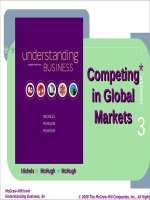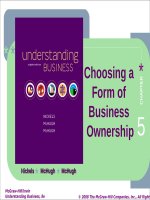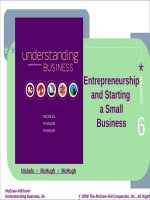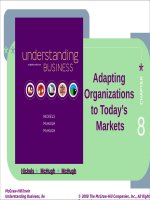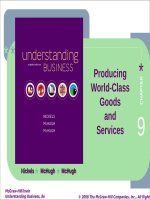Understanding business 11th by mchugh nickels CHAPTER 1
Bạn đang xem bản rút gọn của tài liệu. Xem và tải ngay bản đầy đủ của tài liệu tại đây (3.98 MB, 43 trang )
CHAPTER 1
Taking Risks and
Making Profits
within the
Dynamic Business
Environment
McGraw-Hill/Irwin
Copyright © 2015 by the McGraw-Hill Companies, Inc. All rights reserved.
BUSINESS and
ENTREPRENEURSHIP
• Business Any activity that seeks to provide
goods and services to others while operating at a
profit.
• Entrepreneur A person who risks time and
money to start and manage a business.
• Success in business is often based on the
strategy of finding a need and filling it.
1-2
GOODS and SERVICES
• Goods Tangible products such as computers,
food, clothing, cars and appliances.
• Services Intangible products (that can’t be held in
your hand) like education, healthcare, insurance,
recreation and travel.
• Successfully filling a market need means you
could make money for yourself and provide jobs
for others.
1-3
REVENUE, PROFIT AND LOSS
• Revenue The total amount of
money a business takes in during
a given period by selling goods
and services.
• Expenses The amount of
money a business spends for
production of its goods and
services for sale.
1-4
REVENUE, PROFIT AND LOSS
• Profit The amount of money a
business earns above and
beyond what it spends for salaries
and other expenses.
• Loss Occurs when a
business’s expenses are more
than its revenues.
1-5
RISK
• Risk The chance an
entrepreneur takes of losing
time and money on a
business that may not prove
profitable.
• Not all businesses make
the same amount of profit.
• Businesses take risks, but
with great risks could
come great profit.
1-6
HOW is TAX MONEY USED?
Taxes are used to provide:
•Hospitals
•Schools
•Libraries
•Playgrounds
•Roads
•Fire Protection
•Police Protection
•Environmental Programs
•Support for People in Need
1-7
STANDARD of LIVING
• Standard of Living The
amount of goods and services
people can buy with the money
they have.
• The U.S. has one of the highest
standards of living in the world.
• Workers in other countries may
make more money, but prices for
products are higher.
Photo Credit: Walmart Stores
1-8
QUALITY of LIFE
• Quality of Life The general wellbeing of a society
in terms of its political freedom, natural environment,
education, healthcare, safety, amount of leisure and
rewards that add to personal satisfaction.
1-9
STAKEHOLDERS
• Stakeholders All the people who stand to gain or
lose by the policies and activities of a business and
whose concerns the businesses need to address.
• Who are Stakeholders?
- Customers
- Employees
- Stockholders
- Suppliers
- Dealers
- Community Members
- Media
- Elected Officials
- Bankers
- Environmentalists
1-10
STAKEHOLDERS
1-11
OUTSOURCING
and INSOURCING
• Outsourcing Contracting with other companies
(often in other countries) to do some of the firm’s
functions, like production or accounting.
• Insourcing Foreign companies opening offices
and factories in the United States.
1-12
NONPROFIT ORGANIZATIONS
• Nonprofit Organization An organization whose
goals do not include making a personal profit for its
owners or organizers.
1-13
WELLKNOWN NONPROFITS
in the UNITED STATES
United Way
American Heart Association
Salvation Army
American Cancer Society
American Red Cross
1-14
TEST PREP
• What is the difference between revenue and
profit?
• What is the difference between standard of living
and quality of life?
• What is risk? How is it related to profit?
• What do the terms stakeholders, outsourcing and
insourcing mean?
1-15
THE UPS and DOWNS
of ENTREPRENEURSHIP
The UPS
The DOWNS
The freedom to succeed.
The freedom to fail.
Make your own decisions.
No paid vacations.
High possibility of wealth.
No health insurance.
Hire your own staff.
No daycare.
1-16
WOMEN in the WORKFORCE
Source: Bloomberg Businessweek, accessed October 2014.
1-17
FIVE FACTORS of PRODUCTION
• Entrepreneurs use what they’ve learned to grow
their businesses and increase wealth.
1-18
TEST PREP
• What are some of the advantages of working for
others?
• What benefits do you lose as an entrepreneur,
and what do you gain?
• What are the five factors of production? Which
ones seem to be the most important for creating
wealth?
1-19
WHAT is the
BUSINESS ENVIRONMENT?
1-20
GOVERNMENT’S ROLE
in BUSINESS
Government can promote business by…
1.Minimizing spending and keeping taxes and
regulations to a minimum.
2.Allowing private ownership of businesses.
3.Minimizing interference with the free exchange of
goods and services.
4.Passing laws that enable businesspeople to write
enforceable contracts.
5.Establishing a currency that’s tradable in world
markets.
6.Minimizing corruption.
1-21
CORRUPTION WORLDWIDE
Source: Transparency International, October 2014.
1-22
BENEFITS of TECHNOLOGY
• Technology Everything from phones to copiers
and the various software programs that make
businesses more effective, efficient and productive.
• Effectiveness Producing the desired result.
• Efficiency Producing goods and services using the
least amount of resources.
• Productivity The amount of output you generate
given the amount of input (example: hours you work).
1-23
ECOMMERCE
• ECommerce The buying
and selling of goods online.
- B2C: Business to Consumer
- B2B: Business to Business
1-24
CYBER ATTACKS on BUSINESSES
•
80% of cyber attacks involve weak passwords.
•
Since 2012, there has been an 8% increase in
malware attacks with an average loss of $92,000!
•
Since 2012, there has been a 125% increase in
social media phishing attacks, stealing over $1 billion
from businesses.
•
29% of security breaches are hackers pretending to
be you and resetting your passwords.
Source: Inc., January 2014.
1-25


